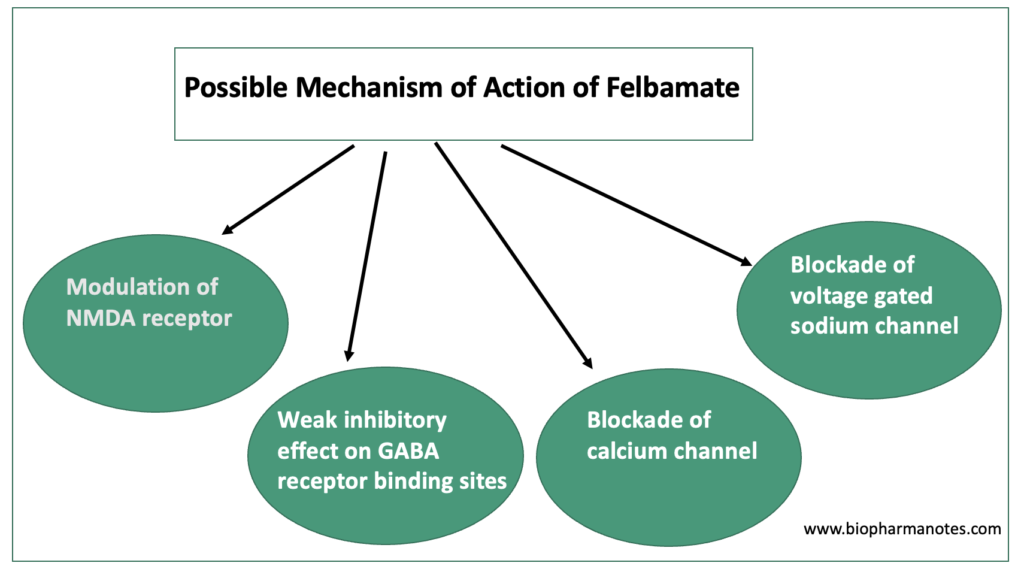
- Felbamate belongs to class of drug called anticonvulsants or anti-epileptics. Felbamate is available in USA and some European countries. Not available in Canada, UK and Australia. Chemically it is 2-phenyl-1,3- propanediol-dicarbamate.
- In August 1993, FDA approved felbamate to treat partial seizures in adults and Lenox- Gastaut syndrome in child (severe form of epilepsy). Due to its risk of aplastic anemia and hepatic failure, it was withdrawn in August 1994. In September 1994, FDA recommended felbamate to be used only in patients with severe epilepsy and list of new risks to be included in packaging.
- It is not available as generic medicine.
Available brand
Felbatol (in US). Taloxa (in some European countries)
Indications of felbamate
- Used to treat seizures in adults. It is only used if its benefits outweigh its risks. Used alone or in combination with other anti-epileptic agents.
- Used in treating refractory epilepsy (mainly Lenox-Gastaut syndrome in children).
Mechanism of action of felbamate

- It’s mechanism of action is not well understood. It is believed to have broad spectrum of anticonvulsant action with several mechanism of action.
- Some of its proposed mechanism of action include:
- Blockade of voltage dependent sodium channels.
- Blockade of calcium channels.
- Weak inhibitory effect on binding sites of GABA receptor.
- Modulation of N-methyl D-aspartate (NMDA) glutamate receptor by competing with glycine co-agonist binding site.
- Modulation of NMDA receptor is mainly responsible for its anti-epileptic action. Blocking of NMDA receptor leads to blockade of excitatory amino acid action which suppress neuronal firing resulting in anti-epileptic activity.
Pharmacokinetics of felbamate
- Available as tablet or oral suspension. Felbamate ablets are available as 400 mg or 600 mg dosage form and oral suspension is available as 600 mg/ 5 ml suspension. It is administered with or without food.
- It has good oral bioavailability. Peak plasma concentration is achieved within 3-5 hours of oral administration. Half-life is around 14- 23 hours. Small amount of administered felbamate (around 24-35%) binds too plasma proteins. Metabolism take place in liver and elimination takes place via urine. Some of its metabolites are p hydroxy felbamate, 2- hydroxy felbamate etc.
- Therapy is started with low dose and is increased in gradual manner.
How to take felbamate?
- Initial dose for adults is 1200mg/day in 3-4 divided doses which can be increased up to 3600 mg/day. In case of children (2-14 years), starting dose is 15 mg/kg/day in 3-4 divided doses which can be increased up to 3600 mg/day or 45 mg/kg/day (whichever is less).
- If using oral suspension, shake well before using. Use accurate dosage by using marked measuring spoon or measuring cup or plastic syringe.
- Take only the amount prescribed by doctor. Don’t stop using felbamate suddenly without doctor’s suggestion. Patient should pay attention if the doctor changes their dosage and writes new prescription.
What to do if a dose is missed?
- If you miss the dose of felbamate, take the missed dose as soon as you remember about it. But if it already is time for next dose, skip the missed dose and continue with your regular dosing schedule.
- Avoid taking two doses at a time to make up for the missed dose.
Adverse effects
- Felbamate can cause some serious side effects like:
- Aplastic anemia (around 1:4000). Aplastic anemia may cause pale skin color, bruising and bleeding.
- Liver problems including hepatic failure, jaundice, and black urine
- Bleeding issues like nosebleeds or bleeding gums.
- Some other side effects include insomnia, weight loss, headache, nausea, mood changes, anxiety, vision problems, dizziness, drowsiness etc.
Drug Interactions
- Felbamate causes induction of drugs metabolized by CYP3A4 and inhibits drug metabolized by CYP2C19.
- Drug interactions are common when felbamate is used with other AEDs (Anti-epileptic drugs). Felbamate can increase blood plasma level of AEDs like phenytoin, valproic acid (by around 20-40%) and may decrease blood plasma level of AED like carbamazepine (by around 20%). Valproic acid and gabapentin may decrease elimination of felbamate, and carbamazepine and phenytoin may increase its elimination.
Contraindications/ Warnings
- Contraindicated in patients hypersensitive to felbamate and other carbamates.
- Should be avoided in patients with history of hepatic failure or blood dyscrasia.
- Should be used with caution in patients with impaired renal function.
- It should be used with caution in patients with history of mental disease.
- Due to risk of severe adverse effects, patients on felbamate therapy should be kept under continuous monitoring for 6-12 months after starting therapy.
- You should let your doctor know if you are pregnant or planning to be pregnant.
- Should be used with caution in geriatric patients.
- You should inform your doctor if you are using any other medicines for seizures or any other health conditions.
Storage
- Both tablet and liquid form should be stored in room temperature in dark and dry place. Should be kept out of reach of children.
Overdose
- In case of overdose (if you take extra tablet or extra spoon by mistake), call, or visit your doctor immediately or visit emergency services.
- Symptoms of overdose are rapid heartbeat and nausea.
References
- https://medlineplus.gov/druginfo/meds/a606011.html
- https://www.ncbi.nlm.nih.gov/books/NBK539799/
- https://www.sciencedirect.com/science/article/abs/pii/S156771920480010X
- https://www.sciencedirect.com/science/article/pii/B9780444640666000101
- https://go.drugbank.com/drugs/DB00949
- Lippincott Illustrated Reviews Pharmacology. 6th edition.